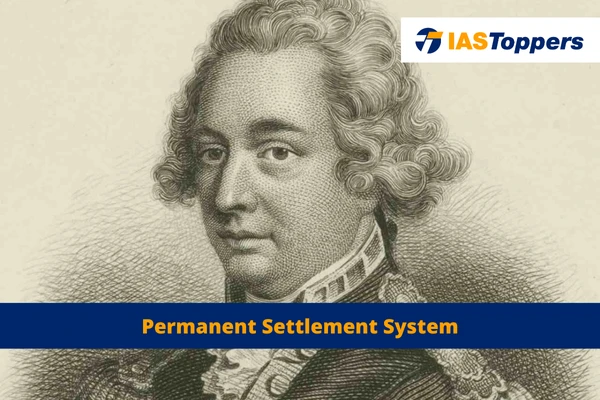The Permanent Settlement System, introduced by the British in 1793, was a tax system where zamindars (landowners) had to pay a fixed amount of tax to the British government. This decision was made to ensure regular tax collection and encourage landowners to invest in improving their lands. However, it heavily burdened the actual farmers, leaving them vulnerable to the zamindars. Over time, many zamindars sold their lands due to high financial demands, leading to merchants and officials exploiting the tenants. In this article, you will know meaning and definition of Permanent Settlement System, along with its impacts. To explore more interesting UPSC Modern Indian History topics of GS Paper – 1 like Permanent Settlement System of NCERT Class 8, check out other articles and IAS Notes of IASToppers.
Table of Content
- What is Permanent Settlement System?
- Background of Permanent Settlement System
- Position of the Cultivators
- Impact of Permanent Settlement System
- Conclusion
- FAQs on Permanent Settlement System
What is Permanent Settlement System?
- It is also known as Permanent Settlement of Bengal, Istamrari, Jagirdari, Malguzari, Bishvedari and Zamindari.
- It determined the fixed land revenues which impacted agricultural practices and India’s rural politics under British rule.
- The original objectives of the Permanent Settlement System were:
- Augmenting tax revenue,
- Establishing a western-style land market in Bengal, and
- Promoting land and agricultural investments for the Company and local people’s mutual economic growth.
- The Permanent Settlement System was introduced in 1793 by the East India Company’s administration under Lord Cornwallis.
- It was part of the broader legislative framework, the Cornwallis Code. The Code split the East India Company’s employees into three sections: revenue, judicial, and commercial.
- The zamindars were responsible for revenue collection, which ultimately created Indian land owners that supported British authority.
- The Permanent Settlement was initially executed in Bengal and Bihar, and later extended to Varanasi, and the southern district of Madras.
- Over time, through a series of regulations initiated on 1 May 1793, it spread across northern India until the introduction of the Charter Act of 1833.
- In 1833, Lord William Bentinck, who was the Governor-General of India, abolished the Permanent Settlement System across all Indian provinces, except Bengal.
Background of Permanent Settlement System
- Previously, zamindars in Bengal, Bihar, and Odisha collected revenue for the Mughal emperors.
- After the Battle of Buxar in 1764, the East India Company took over, but they lacked trained administrators, leading to revenue mismanagement.
- The famine of 1770 was a consequence of this negligent approach. It made the company realize the need for proper monitoring of revenue officers.
- This led to five-year inspection cycles by Warren Hastings, the then governor-general. However, these officers often misused their power between inspections.
- To address these issues, Charles Cornwallis was sent out to India to reform the company’s practices in 1786.
- He linked the downfall of handicrafts to the failure in agriculture, and recognized the problem of corruption and arbitrary taxation, which was destabilizing the system.
- As a solution, Cornwallis decided to permanently fix land taxes, promising no future increases. This decision was expected to:
- Reduce corruption by eliminating the officials’ freedom to arbitrarily change the tax assessment.
- Encourage landholders to invest in land improvement, as they would retain all benefits from increased production.
- Increase production and trade, and ensure regular tax collection.
- Despite the fixed land tax, the government could levy taxes on trade and commerce when necessary, considering the high fixed land revenue.
- The Permanent Settlement came into effect with existing Rajas and Taluqdars, now known as Zamindars.
- Under the Permanent Settlement of Bengal in 1793, which was later expanded to coastal Madras and parts of North-Western Provinces, these Zamindars were granted ownership if they paid a set land-revenue to the East India Company.
- The Zamindars consequently became sole land proprietors, and this ownership could be transferred or inherited. The peasants were at their mercy.
- The British expected landholders to invest more in their lands with the surplus from fixed tax amounts, hoping this would create a class of wealthy landowners, loyal to the British.
- However, the challenge was to find individuals ready to commit to paying fixed revenue forever.
Position of the Cultivators
- Farming activities were managed by the lakhs of peasants, who were now reduced to the tenants of zamindars due to Cornwallis’ decrees.
- Cornwallis insisted that the zamindars provide written contracts (known as pattas) to every farmer, outlining their financial responsibilities. This action was intended to guard against possible exploitation.
- However, written agreements never came into existence, leaving the peasants defenceless.
- This unfortunate situation wasn’t unintentional. It stemmed from the fact that the permanent assessment, the largest sum that could be got from the land, was aimed at maximizing financial extraction.
- As per the calculations of John Shore, if crop yield from a piece of land was valued at Rs. 100, Rs. 45 was claimed by the government, Rs. 15 by the zamindar, leaving only Rs. 40 for the actual farmer. These exorbitant levies could only be collected through harsh measures.
- If the zamindars were restricted from imposing their will on the peasants, they wouldn’t be able to fulfill the state’s expectations. Accordingly, the state gave zamindars the power to confiscate the tenants’ assets if the rent wasn’t paid, under the laws passed in 1793, 1799, and 1812.
Impact of Permanent Settlement System
- The Permanent Settlement appeared to favor the zamindars, although they were required to pay a set sum at predetermined times, with failure leading to a loss of their zamindari.
- The high financial demands often left zamindars vulnerable to unpredictable calamities. Many ended up selling their lands post-settlement.
- About 68% of zamindari land in Bengal was sold from 1794 to 1819 to merchants, government officials, and other zamindars. They aimed to increase their profits by hiking up the tenants’ rents.
- Over time, the population of Bengal grew, bringing uncultivated lands under cultivation, which raised the rents. However, the zamindars’ tax remained constant. This allowed the zamindars to live luxuriously off their tenants.
- Only in 1859 were tenants granted some protection by the state, with a law providing limited safety to old tenants, who were then referred to as ‘occupancy tenants’.
- Moreover, there was changes in the Zamindar class composition due to speculators and merchants’ involvement in revenue farming since the 1760s.
- Initially, the Zamindars would contribute 10/11ths of their assessed rent to the colonial state, keeping 1/11th for themselves. However, the land-revenue was fixed in perpetuity. If the rental of a Zamindar’s estate increased due to the expansion of cultivable area or rise in productivity or simply due to his capacity to extract morg from the tenants, he was entitled to keep the entire amount of the increase.
- As a result, most of the tenants including the pre-existing Khud-khast tenants enjoying occupancy rights in their lands could now be easily evicted by Zamindars.
- Many peasant customary rights, like access to forests, use of village ponds, and growing vegetables on homestead plots, were revoked.
- Despite these changes, the settlement provided financial stability for the colonial state, creating a group of Zamindars whose economic interests aligned with supporting colonialism.
- However, the high initial land-revenue assessment led to widespread defaults and the sale of Zamindaris. The Zamindars also lost their traditional roles, like maintaining law and order.
- Despite some restructuring, there was a significant continuity of the old indigenous power structure. The Zamindars, key supports of the pre-colonial Bengal polity, were given judicial and administrative duties.
- Unlike their counterparts in the Deccan, South, and North, the Zamindars lacked significant military capabilities. This eased the colonial state’s control over the colony.
- The colonial state equipped them with additional powers, such as the right to arrest tenants and auction their goods and cattle for overdue rent through Regulations VII of 1799.
- They were also permitted to collect Abwabs (illegal cesses), despite being stripped of their traditional roles.
Thus, the immediate aftermath of the Settlement was a significant deterioration of the situation for the actual cultivators of the land, indirectly favoring the zamindars and the British Government.
Conclusion
While the Permanent Settlement System streamlined tax collection and created a class of wealthy landowners supporting the British rule, it led to a significant exploitation of the actual cultivators. Over time, it also caused a shift in land ownership and control, altering the socio-economic fabric of rural India. The policy had far-reaching consequences, some of which are still felt in the rural parts of the country.
Ref:Source-1
| Other Articles in History & Culture | |
| Ryotwari System | Bardoli Satyagraha(1928) |
| Indigo Revolt in Bengal | Land Revenue Systems in British India |
| Mahalwari System | Ahmedabad Mill Strike, 1918 |
FAQs(Frequently Asked Questions)
What is the difference between mahalwari system and permanent settlement system?
The Mahalwari system, unlike the Permanent Settlement System, collected revenue directly from a group of peasant households (mahal), while the Permanent Settlement system collected taxes from the zamindars, who were made the landowners with fixed tax responsibilities.
What are the main features of Permanent Settlement System?
Key features of the Permanent Settlement System included fixed land revenue, zamindars as tax collectors and landowners, and revenue being used to support British authority. It also led to the creation of a western-style land market in Bengal, aimed at enhancing agricultural investments.
What are the merits and demerits of permanent settlement system?
Merits of the Permanent Settlement system include stable tax revenue, creation of a loyal class of landowners, and encouragement of land and agricultural investments. However, its demerits include exploitation of peasants, high instances of zamindars selling lands due to financial strain, and increased tenant rents.



